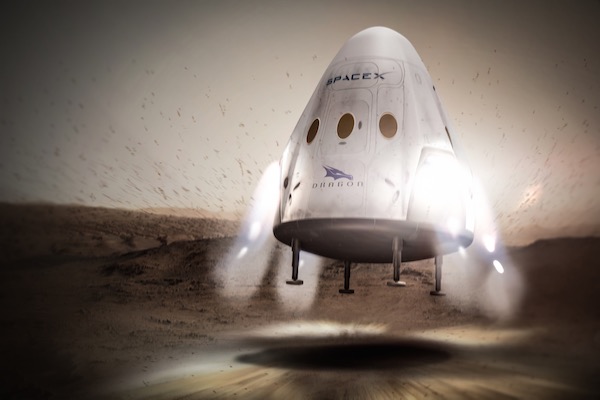Human missions to Mars: questions of who and whenby Jeff Foust
|
| “I think the downside of reckless missions that squander the lives of brave crews would be a loss of support and questioning from the public and policymakers who we will rely on for support,” Cassady said. |
While there are debates about the details of that strategy—Congress has frequently called for more details about that architecture that NASA has argued are premature to finalize now—there’s less debate about the destination. The disagreement is not about the where but the when: how long will it be before humans set foot on the Red Planet? While NASA works towards a human mission at least to Mars orbit some time in the 2030s, a goal set by President Obama in 2010, there are others who want to accelerate that schedule, and think one company may hold the key to doing so.
The dangers of the triple-S
The timeline for a human Mars mission was the subject of a debate during the Humans to Mars Summit in Washington May 17. Speaking out in favor of a timeline roughly consistent with NASA’s long-term vision was Joe Cassady, executive director for space at Aerojet Rocketdyne and a member of the board of Explore Mars, the advocacy group that organized the conference.
“The first landing date is April 2033,” he predicted. “Launch of the crew is September 2032.”
That timeframe (which happens to coincide with a particularly favorable launch window for Mars missions) strikes a middle ground, he argues, between those seeking a more rapid approach to such missions and those who want to “wait until we have a better way to go.” He largely dismissed that latter group, who want to wait until better technologies emerge for going to Mars, like breakthrough propulsion systems, before going to Mars.
Cassady was more sympathetic towards those who want to go there faster. He summarized their approaches as endorsing the “triple-S”: simple, straightforward, and soon. “While I share the passion and the impatience of many who favor the triple-S, my inner engineer just sees too many hurdles,” he said.
With those hurdles, he said, come risks that pose a threat to an overall humans-to-Mars plan. “I think the downside of reckless missions that squander the lives of brave crews would be a loss of support and questioning from the public and policymakers who we will rely on for support.”
That program, he argued, would require the government, not the private sector, to take the lead. “Mars is a challenge that will take a commitment of resources and political will that is unprecedented,” he said. “But it is also a challenge that will marshal the best of our common capabilities.”
| “NASA, or really the administration, which directs NASA, currently has no Mars plan,” Zubrin argued. |
Cassady cited studies that showed how a human Mars mission could be flown in that timeframe without a massive increase in spending that an earlier mission might require. “There’s no need to reprogram funds from other parts of the budget,” he said. “There’s no need to have large increases in the NASA budget, as was done under Apollo.”
Mars in the next administration
Advocating for a faster, or triple-S, approach for human Mars missions at the debate was Robert Zubrin, founder of the Mars Society and a longtime advocate for human Mars missions done relatively quickly. He thought little of NASA’s current plans.
“NASA, or really the administration, which directs NASA, currently has no Mars plan,” he argued. He was unimpressed with NASA’s Journey to Mars plans, including its Asteroid Redirect Mission (ARM). “This is not on the critical path,” he said of ARM. “This is a random act which is supported by its own constituency.”
He argued that NASA was actually well positioned to do a humans-to-Mars sprint. “Despite all the difficulties, real, exaggerated, or simply imagined, that stand in the way of sending humans to Mars, the fact of the matter is that we are much closer today to sending humans to Mars than America was to sending men to the Moon in 1961.”
He suggested that the next president could start such a program and see it at least most of the way through by the end of his or her second term. “If the next president was to start a humans-to-Mars program that was serious after inauguration, we could be landing on Mars—well, we could certainly be taking off for Mars—by the end of her second term,” he said.
Zubrin, no stranger to strong rhetoric, argued that an unwillingness to adopt a fast-paced approach to Mars missions, like the US did in Apollo, was evidence of a greater weakness. “Frankly, to say that we are unable to take on this much smaller challenge within a comparable time frame is saying that we have become much less than the kind of people we used to be,” he claimed. “It’s an acceptance of American decline.”
 Joe Cassady (left) and Robert Zubrin debate timelines for human Mars missions at the Humans to Mars Summit in Washington on May 17. (credit: J. Foust) |
The SpaceX factor
That debate was largely focused on NASA-led human missions to Mars, ones that might feature commercial and international partnerships but which would still be run by the space agency. But a backdrop to the debate, and to the whole conference, was the prospect of a commercially-led mission by SpaceX.
On April 27, SpaceX announced it was planning to launch an uncrewed Dragon spacecraft as soon as 2018 on a mission dubbed Red Dragon. The spacecraft would land on the surface of Mars, demonstrating the entry, descent, and landing technologies that SpaceX says could support future human missions to the planet.
Red Dragon itself is not new: SpaceX has been working on it for several years, including early studies done cooperatively with NASA. What is new here is that SpaceX and NASA modified an existing unfunded Space Act Agreement to support work on that Red Dragon mission, whereby NASA provides SpaceX with technical support in a variety of areas, and SpaceX in return provides NASA with Mars landing data to support the agency’s plans.
| “It ruffles a lot of feathers when you say you’re going to do that,” Bolden said of SpaceX’s Mars plans. As for competition, “nothing could be further from the truth.” |
SpaceX and its founder, Elon Musk, of course, have made it clear they see human missions to explore and ultimately settle Mars as a long-term goal of the company, hinting the first human missions could come as soon as the mid to late 2020s. Musk plans to reveal more details about his Mars architecture in September at the International Astronautical Congress in Guadalajara, Mexico.
NASA, though, has played down any idea of competition with SpaceX on human Mars missions. “It ruffles a lot of feathers when you say you’re going to do that,” NASA administrator Charles Bolden said of SpaceX’s Mars plans at a May 23 breakfast event in Washington. As for competition, “nothing could be further from the truth.”
At the conference debate, Cassady and Zubrin were split on how effective commercial human Mars ventures, by SpaceX or others, could be. “There’s a common misconception today that private parties could attempt this historic undertaking without any assistance, and this is far from true,” Cassady said. “No one with an understanding of the problem believes that.”
Zubrin, by contrast, saw SpaceX’s Mars plans as, at the very least, providing new motivation for NASA. “SpaceX has, quite literally, ‘Sputniked’ NASA. This is remarkable stuff,” he said, adding that he was impressed by both SpaceX’s technical capabilities, such as landing rocket stages for potential reuse, as well as their lower costs.
He added that SpaceX’s claims that it could develop a heavy-lift launch vehicle for as little as $2.5 billion, dismissed when proposed by Musk during the 2009 Augustine Committee deliberations, should be taken more seriously now. “It is quite possible that the activity that we see at SpaceX could be the key to leveraging the next administration to launching a humans-to-Mars program.”
So far, neither the presumptive Republican presidential nominee, Donald Trump, nor the likely Democratic nominee, Hillary Clinton, have suggested they would support an accelerated human Mars program that Zubrin desires—or, for that matter, support a humans-to-Mars program at all. Clinton has said little on the subject, and Trump previously suggested he favored spending on infrastructure over human Mars missions. (Asked specifically about it earlier this year, the Trump campaign responded that it “depends on our economic state,” which also included getting “military readiness back to acceptable levels,” on his willingness to support any such plans.)
NASA, at least, does not appear to be planning for an accelerated Mars program. Earlier in the conference, an audience member asked NASA deputy administrator Dava Newman if the agency had a “get us there fast plan” if there was some motivation, such as a Sputnik-like Chinese milestone that spurred a race to Mars.
Newman dismissed any prospect of a Mars race with China. “Right now they have no plans, in the near term,” to be at Mars,” she said of China. (The country does have plans for a robotic Mars mission, including a lander and rover, in 2020, but has not expressed any plans for human missions there, with human lunar missions now pushed back into the 2030s.) “Get us there quickly? That’s our investments in the Space Launch System.”
One person not fond of the SLS, or other aspects of NASA’s plans, is Buzz Aldrin. In a speech at the conference, he was critical of NASA’s overall approach, calling for a more focused, but not necessarily faster, plan that would lead to permanent occupancy on Mars by about 2040.
“The president who appeals to our higher angels and takes us closer to the heavenly body we call Mars will not only make history, he or she will be long-remembered as a pioneer for mankind to reach, to comprehend, and to settle Mars,” Aldrin concluded. “And if not now, when? And if not us, who?”
